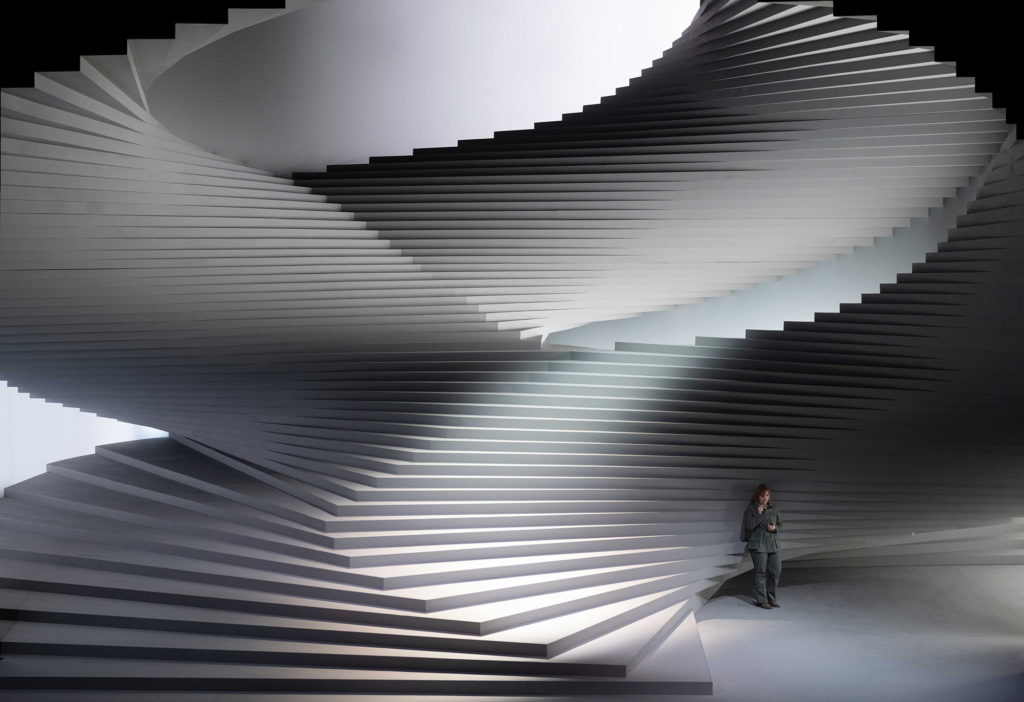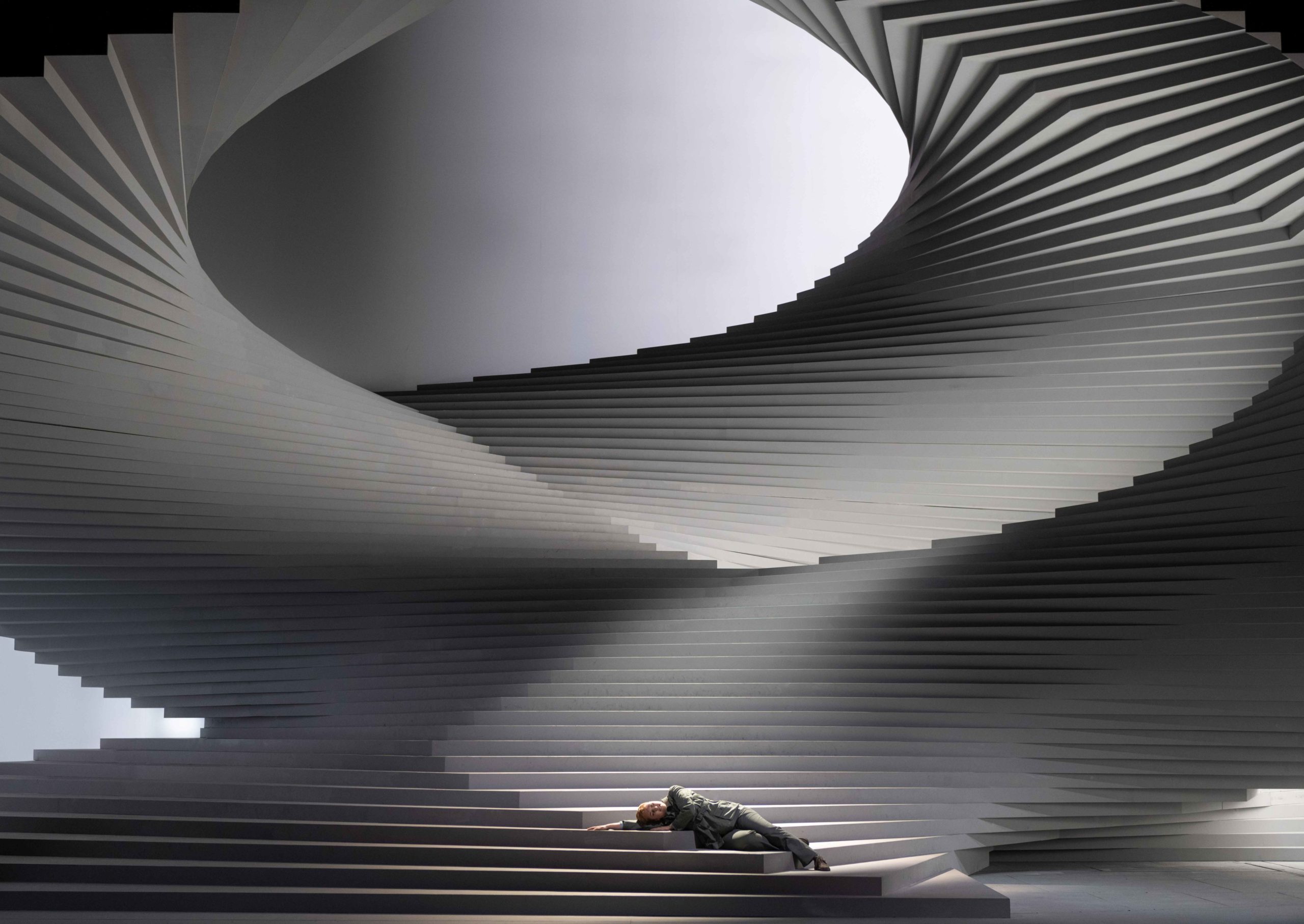When renowned US-German architecture firm Barkow Leibinger was approached by the Oscar-winning actor Christoph Waltz to help realize the stage design for Beethoven’s opera, Fidelio, in honor of the composer’s 250th birthday, the set they conceived for Vienna’s Theater an der Wien was bold and innovative. But on the eve of its premiere, the live production became yet another victim of the global pandemic.
“The world was crashing down quickly,” recalls Frank Barkow (MArch ’90), co-founder of the firm with his partner, Regine Leibinger (MArch ’91). “We were hoping to make it by March 16 for the premiere, but within a week of that the Austrian government announced no gatherings of more than 100 people in an interior space—so that was that! It was always going to be filmed at some point, but it meant that we focused on that rather than the opening. We only had a week to film it. So we took the seats out of the theater and put down camera tracks.”
It’s an interesting typology for an architect to look at, with the idea of lighting as something dynamic and transformative and movement that’s choreographed in a very specific way. It made me rethink conventional architectural projects, about what that is and how people experience your buildings and how they can occupy them in ways that are less predictable.
On translating the immersive experience of theater to a two-dimensional screen
The need to adapt the set for filming was an unforeseen demand made on what was already an intentionally flexible design. “I had this idea about a double helix as a way of creating a structure that was adaptable to the scale of the stage,” Barkow explains. “We could distort it; we could create different entrances and exits for it.”
The timber-built intertwining staircases evolved from several conversations with Waltz—a neighbor of Barkow’s in Berlin. “He lives more or less across the street, so I went over there and we had a beer or two and started sketching,” says Barkow. “He wanted a certain amount of distraction and a certain amount of vertical displacement.” Waltz was, it turns out, well versed in the language of design. His father was a set designer, his mother was a costume designer, and his wife, Judith Holste, created the Maoist costumes for the cast.
Among the references Barkow and Waltz incorporated into their plans were the work of the Czech scenic designer Josef Svoboda and the labyrinthine etchings of the 18th-century Italian artist Piranesi (“…but to somehow translate that into something that was more abstract”). The final, versatile stepped design provided practical as well metaphorical solutions to Waltz’s requirements.
“At the beginning, there’s this guy—a stuntman—who gets thrown down the length of the stairs,” says Barkow. “He goes head over heels. We tried to exploit the condition of the stairs as much as we could, so at one point the governor is intimidating someone by looking down on them. I think it shows in a sensuous way how the singers can interact. Sometimes there are overhangs which create a kind of cave; or the edges become awnings. I think they really used the set to enhance the activity in the opera as much as they could.”
It also proved to be a boon for Manfred Honeck, the conductor, both acoustically and visually. “The topographical aspect was really interesting,” adds Barkow. “It had a crucible aspect to it—which you can only really experience live, but it projected the sound out. Manfred was super happy with the acoustic performance, as well as with the fact that he had visual contact with every single singer on the stage. Unlike with a two-dimensional flat stage, where the views of the back disappear, he had perfect sightlines on anybody moving on this stage, which is important for him to have command both over them and the orchestra in the pit.”
Constructed in components in Poland and first assembled off-site in a warehouse in Vienna, the set was then broken down in order to fit through the relatively small loading doors of the historic theater. It was reassembled “like a ship in a bottle”—the lower, “habitable” half connecting, jigsaw-like, with the top half, which is suspended from the ceiling. “Because it’s all made of timber, the whole thing can be broken down and stored and rebuilt again,” explains Barkow. “Ultimately my hope is that it can be shown live in the future.”

The final piece of this elaborate puzzle took shape in Atlanta—when the design team took their architect’s model to show the cinematographer Henry Braham. Barkow says, “He was doing a film—another Guardians of the Galaxy I think it was. He’s a real genius. We started talking with him about how to light this thing and he suggested putting an LED scrim around the back perimeter of the set, and then putting a diffuser in front of that, so basically we could create any condition of light or color that we wanted. He did that in a week!”
Having perfected their groundbreaking, innovative design, a new challenge emerged: how to adapt it for an entirely different audience—one sitting at home, experiencing on a 2D screen what was intended to be an immersive, live experience. Not to mention the loss of the set’s acoustic qualities—or the unique dynamic of live theater, where audience reaction is a vital part of the ambience. But with a Hollywood cinematographer on hand to advise the TV crews, they were able to produce a professional broadcast, adapting the lighting and making use of close-ups and cutaways that are alien to theater productions. “The fact is, had we premiered this and performed it maybe six times, then 7,000 people would have seen it,” points out Barkow. “But with the broadcast, 700,000 to 800,000 people have seen it already.”
The experience has also highlighted new possibilities and opportunities. “Conceivably you could construct everything digitally. Of course, film is doing this anyway with CGI, so what if we ended up with digital images on a TV screen? I remember at Harvard, as students you’re constantly working with representations, drawings, and models of some physical thing. This is almost the opposite, it could have just been a digital representation that we ended up with—a virtual film set. It’s an interesting conversation, what this might mean. Maybe we start producing architecture that is not experienced physically? Already we’re doing this with home-officing, teleconferencing. It would be a great tool to have three-dimensional models that were used to walk through and communicate our ideas.”
It also brings up some interesting conceptual considerations. Barkow continues, “I’d gone to a lecture by Herman Hertzberger a few weeks before we opened, and he was talking about this idea of pure space, which in a way this set is. It doesn’t exist as an object, it exists in relation to the space of the theater. There’s a history of set design from architects: from Schinkel to Gehry to Herzog & de Meuron. I think it’s a really interesting typology for an architect to look at, with the idea of lighting as something dynamic and transformative… and movement that’s choreographed, in a very specific way. It made me rethink conventional architectural projects, about what that is and how people experience your buildings and how they can occupy them in ways that are less predictable. So I think the exercise will make me think differently about architecture going forward. It was kind of a lesson for me.”
Whatever the positive outcomes, however, there remain some drawbacks for Barkow. “I would reiterate that what really is missing from the live experience, besides sound and action, is the spatial and formal relationship between the baroque historical theater–which is also vertical and topographical. These two ‘halfs’ created a new and continuous spatial entity between performers and audience.”
However ingenious the short-term solution, the fact remains that theater is fundamentally a live and uniquely interactive experience. The show may go on, but without the audience, it becomes diminished.
